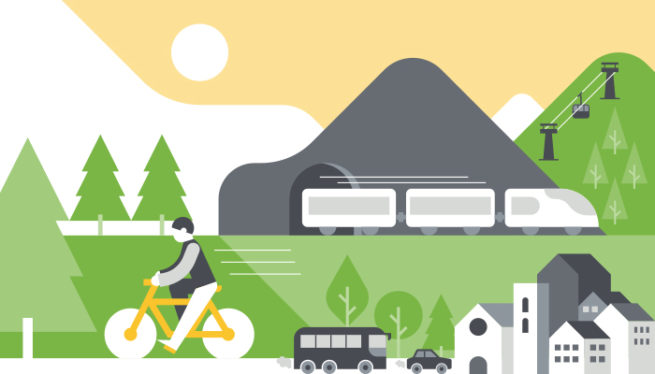As a part of Blogchatter’s CauseAChatter program for the last few months, I have been trying to voice different causes and has been discussing them with various crusaders who want to work for the betterment of society and the environment. During one such interaction, I was introduced to Calcutta Tram Users Association(CTUA).
CTUA is a citizen’s forum, formed in December 2016 to create public awareness about the benefits of trams in general, garner public support for the ailing tram system of Kolkata and also find ways for the betterment of the city’s tramways. The epochal Calcutta tramcars, the first one in Asia, that made its appearance in 1880, and was once the lifeline of the city’s transport system, is currently the only one running in the country. I always thought they are trudging due to their heritage value and the emotional attachment with the city. But as I discussed with Arghyadeep from the forum of CTUA I learnt about the concept of a sustainable urban mobility plan and the important role trams can play in it. He explained how the tram can rise above its nostalgic value and help the betterment of the deteriorating environmental impacts in the long run by promoting sustainable mobility around the city.
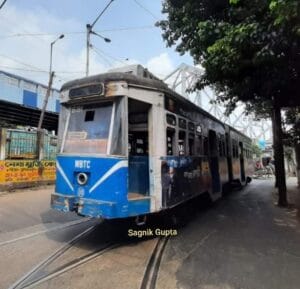
I started researching more about it and voila, what an important issue that is never discussed much. So my final blog for this year’s #CauseAChatter is dedicated to sustainable urban mobility plans and Kolkata’s favourite Trams
Urban Mobility Challenges
Cities are presently the lifeline of the countries. Being the major driving force for the economic growth of the nation, the rural population is slowly shifting to a more city-based accommodation for better employment opportunities and finer facilities. To accommodate this growing requirement of space for residential and commercial purposes, the urban boundaries are expanding. Often this extension is going on in an uncoordinated manner, especially in developing countries like India. This leads to road congestion and restricted mobility of the citizens. Further urban transport is a major consumer of energy and emitter of greenhouse gases. If transport infrastructure and public vehicles fail to keep up with the mobility needs of the growing population the result is overdependence on private vehicles and informal paratransit. The growing use of personal motor vehicles contributes to traffic congestion, poor air quality, declining public health, and growing pressure to implement costly road expansions. Thus comes the need for Sustainable Urban Mobility Plan.
An Urban Mobility Plan is a planning tool that comprises objectives and measures oriented towards safe, efficient and accessible urban transport systems. With a goal towards saving energy, leading a more sustainable lifestyle and improving the quality of life we require Sustainable Urban Mobility Plans (SUMPs) at regional and local levels. SUMPs define a set of interrelated measures designed to satisfy the mobility needs of people and businesses of the present and future.
Difference between traditional transport plan and SUMP
The major difference between traditional transport plan and SUMP is that while the traditional process focuses on traffic and infrastructure, SUMP focus on people and an integrated set of actions to achieve cost-effective solutions. The new planning paradigm promotes a shift from a car-oriented planning approach to planning with people as its focus and support the use of sustainable modes of transport.
Further, the objective of traditional planning is prepared keeping in mind the traffic flow capacity and speed, fixating mostly on a particular mode of transport. On the other hand, the urban mobility plan includes balanced development of all relevant transport modes and a shift towards cleaner and more sustainable transport modes. Their objective covers the accessibility and quality of life, as well as sustainability, economic viability, social equity, health and environmental quality.
Both the approach strives towards short- and medium-term delivery plans, but SUMP embeds in a long-term vision and strategy. Thus it invites a transparent and participatory approach for all relevant stakeholders and interdisciplinary teams.
Optimization of cost through SUMP
Cost is one of the most important features in any transport planning as financial resources are always limited. Thus it is important to ensure that the solutions adopted make the most cost-effective use of the funds available. Due to limited financial and human resources, cities need to choose the right measures in the local context to improve the sustainability of their transport systems.
There are a large number of measures with relatively low or even negative costs, which can be integrated with practically every Urban Mobility Plan.
1. Public transport prioritisation – By introducing priority signalisation and bus lanes and shifting the focus from car-based planning to public vehicles a lot can be achieved.
2. Walking and cycling-friendly improvements – The minimum requirement is for pedestrian access and parking facilities for cyclists.
3. Parking management – Regulating parking fees and imposing higher prices, where there is high parking demand/limited public space can help in curbing the unlimited use of private cars
The process is complex and requires the teamwork of various stakeholders with a view to comprehensive planning and execution. Attaching a snapshot of the processes that are essential and to be undertaken for a successful implementation of SUMPs at the local level.
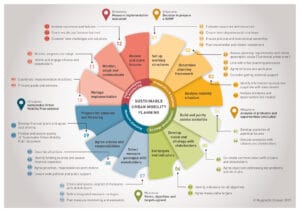
In India sustainable urban transport is the way forward
City and state governments have already started to embark on a sustainable and equitable urban mobility pathway. The National Urban Transportation Policy (NUTP), launched in 2006, aims at providing better mobility and sustainability by focussing on people mobility and not vehicle mobility.
However, the progress is not yet satisfactory. For India to achieve resilient and inclusive cities, it is necessary to continuously plan for a low carbon model of growth in our cities. What is missing is adequate infrastructure for moving people through means, such as bicycle tracks, low carbon public vehicles(such as tram, monorail) and dedicated pedestrian pathways.
But the challenges are far and many. The pedestrian pathways are being encroached upon by hawkers or are not walkable because of being broken or lined with garbage, etc. Similarly, the cycle tracks are being misused by motorbikes and pedestrians. The present focus is on building roads and flyovers to cater to the ever-increasing vehicular traffic of India which is a costly and lengthy affair. The need of the hour is to focus on public transportation (PT) in India, especially, low carbon non-motorised transport (NMT).
And can you guess one transport that fits the bill of low carbon, non-motorised, comfortable public transport? Of course our very own trams or the light rail system. Especially in Kolkata where the tram is still trudging along it can serve as a readymade solution.
Tramways a ready solution overlooked
The last surviving tramway system in India has been on the decline for many years due to a lack of investment in the ageing infrastructure and fleet. But braving the odds they still thrive in the Kolkatan roads. It is a fact that tramways or light rail systems are the ultimate solutions to the transit problem of all megacities. So it is high time to save the city from congestion and pollution from other modes of transport and implement a sustainable urban mobility plan, the ailing tram system must be revived.
All the infrastructural facilities as well as capabilities of the Calcutta Tramways, including the manufacture of new rolling stocks, already exist. Therefore, no major investment is required to restore the lost glory of the city’s tramways.
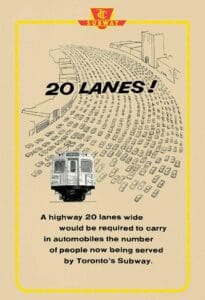
The above is just a snapshot of how a change in transport helped a city.
Advantages of Tram
Trams provide greater passenger capacity and thus can reduce congestion in city centres by providing people with a comfortable, reliable, high-quality alternative to the car. As part of an integrated public transport system, tramways can attract motorists out of their cars and thus reduce the number of vehicles in the city centre. This not only reduces the number of vehicles moving on the street but also reduces the demand for city parking.
They improve local air quality because they run on electricity so don’t produce any pollution at the point of use. They are very quiet and safe.
Further, the tram can be regarded as the cheapest mode of transport, thus benefitting the lower-income strata.
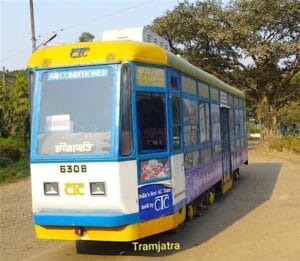
Demands for the revival of the tram system
CTUA aims to open a constructive dialogue with the State Government to find ways of resurrecting and reviving the tramways. They have undertaken various activities like protest vigils, distribution of leaflets, taking part in forums and seminars, engaging with the media, signature campaigns, petitions and online campaigns to raise awareness about the need to modernise and expand the city’s tramways.
As per the press release for 26 December 2021, CTUA has placed some valid demands for the revival of trams in Kolkata in front of the Government.
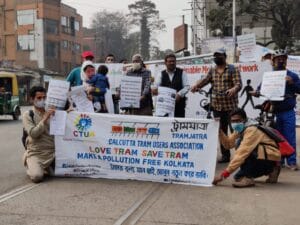
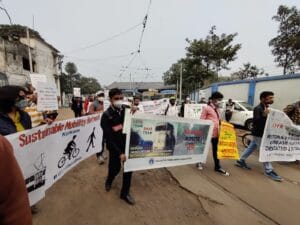
Summarising some of them below –
1. Restoration of closed routes and reopening of disrupted routes – Route no 36 (Esplanade – Kidderpore) is closed since cyclone Amphan messed up the overhead wiring in May 2020. It traverses one of the busiest routes of Kolkata offering the most picturesque slice of the city of joy on its way. Immediate restoration of the route is needed.
All existing tram routes that have been closed, at locations like Gariahat flyover, Sealdah flyover, Belgachhia overbridge must be immediately revived.

2. Improved frequency and optimum utilisation of fleet – Make all tramcars roadworthy and recruit essential manpower at every point to run tramcars at full capacity. Increase tram frequencies (10 minutes) in all routes especially during peak office hours both in the morning and evening. The tram frequencies can be increased by using many of the operational trams currently not in use, that are stored in tram depots. This will create new employment as well as increase revenue.
3. Cooperation from authorities – The Transport Department, Kolkata Traffic Police and the Kolkata Municipal Corporation should change their hostile attitude towards the tramways and take tangible steps to provide a sustainable tram service in the city of Kolkata. Also, ensure that the traffic police stop interfering in the movement of tramcars.
4. Modernization of the tram cars – Manufacture of new tram cars at Nonapukur workshop should start immediately to provide a faster and modern version of the light rail.
5. Boost the image of trams – WBTC should utilise virtual platforms like the WBTC website and social media platforms to spread awareness of the improved services. WBTC should prepare and display tram maps, timetables and new tram stop signs at prominent tram stops and transit hubs so that commuters can get adequate information about the newly upgraded tram services.
Conclusion
These initiatives will help the WBTC in providing affordable, clean and reliable public transport to the citizens of Kolkata thus taking some positive steps towards a sustainable urban mobility plan for the city. You can also join the cause in the demand for a greener Kolkata. Sign the petition.
Please add your name to our petition for the Govt of West Bengal to invest and modernise Kolkata’s tramways.
Petition to WB Govt to invest and modernise Tramways
–X–
This post is part of Blogchatter’s CauseAChatterCauseAChatter
***********************************************
Kolkata is beckoning you. Read the A to Z chronicles of the mesmerising city of joy on my new book Tilottama at Glance. The book is now available in Amazon, Google Play and website of Ukiyoto.

